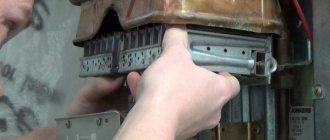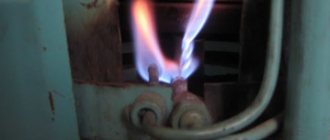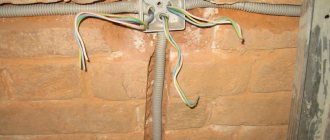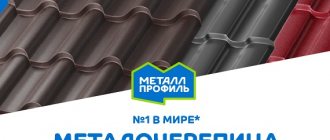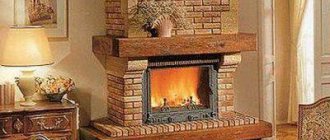The home cooking community has been arguing about the quality of baking in a gas oven for many years. Some believe that gas is the best thing that can be invented for beautiful pies, while others argue that all their culinary masterpieces perish due to the incorrect operation of such an oven.
Almost all household appliances fail sooner or later, and the pies and other dishes that the housewife so diligently prepares do not bake or burn.
In fact, there are no clear answers to the questions “Is a gas oven good to use?” and “Why doesn’t the oven bake well?” does not exist. The quality of the resulting product depends on many factors - the experience of the cook, the degree of his “familiarity” with the stove (each has its own nuances that can only be learned over time, they are not written about in the instructions), the build quality of the oven (a couple of millimeters of clearance and that’s all, the effect is different).
One of the reasons for uneven baking of pies, cakes and other things in a gas oven, according to experts, is a violation of the seal of the chamber.
Experienced gas technicians are able to identify the “disease” instantly, but for this, a home cook will need to study some aspects and features of the gas assistant’s behavior.
Some gas ovens have thin factory insulation installed, which allows heat to pass through. If a fact is discovered, it is better to seek help from a specialist to replace the existing insulating material with a better one.
The gas stove smokes - why?
During normal operation of the gas stove, the flame should be bluish and not smoky. Any changes, be it the red-yellow color of the fire, or the smoked bottom of the cookware, are evidence of improper operation of the device. Since gas is an increased source of danger, all work on repairing gas equipment must be carried out by competent specialists with a special permit.
If a Gefest, Hansa or another brand of gas stove is broken, do not attempt to repair it yourself. It may be dangerous. The correct solution would be to contact. For more than 5 years, our craftsmen have been repairing gas stoves at home in St. Petersburg and the region. You can call a specialist by phone +7 (812) 324-97-77, we work seven days a week from 7:00-23:00. If you submit an application before 12:00, a specialist will arrive on the day of your application.
Causes of soot
Due to the gas mixture
The correct operation of the stove is assessed by the quality of the flame. Normally, the gas ignites when it mixes with oxygen in the air. For normal combustion, the ratio of natural gas to air volume should be 1:10. Then the mixture (it consists of methane with the addition of propane, butane and ethane - for centralized supply, in a cylinder - with propane) burns completely and evenly, the flames are the same size and bluish-blue in color. As a result of combustion, carbon dioxide and water vapor are formed.
If the gas mixture contains impurities, or there is not enough oxygen in the air for combustion, the flame turns yellow-orange or red and the burner begins to smoke. When burned, carbon monoxide and hydrogen are produced. The problem in this situation is not that the pan is smoked. What is much more dangerous is that due to incomplete combustion of gas, harmful substances are formed that accumulate in the air and can cause harm to health or cause a fire.
Burner malfunctions
- The nozzle hole is clogged.
- The flame breaker is deformed.
- The divider cells are clogged.
As a rule, only one or several burners produce soot. A good cleaning will solve the problem.
In a centralized supply
If all burners smoke, this may indicate the following problems:
- The settings regulating the gas pressure have gone wrong. If gas is supplied under higher pressure than necessary, it will not have time to burn out completely.
- The flow of air that mixes with gas is not adjusted. Some tile models are equipped with air flow adjustment. If they are confused, then air does not flow in the required volume for complete combustion.
- Foreign impurities in the gas mixture. This is a very rare occurrence, because... The quality of the mixture is very strictly controlled.
When using bottled gas
The composition of bottled gas is somewhat different from natural gas. It can contain either pure propane or a mixture of propane and butane. In addition, the gas in the cylinder is under high pressure, which liquefies the fuel.
Advice from an experienced stove maker.
Often, just because the stove is smoking, people try to change it right away.
You look at the doomed stove, and there isn’t even a crack in it. You ask the owners: “Have you cleaned it?” But they don’t even know that the oven is being cleaned and where the cleaning spots are. Clean this stove and it will be like new! What will happen to it if it stands on a good foundation! True, sometimes it is difficult for a stove maker to find places to clean in someone else’s stove, because each stove maker made and makes his stove in his own way. Each stove maker has a different stove inside, and from the outside you won’t know where the flues are vertical or inclined, and where they are horizontal or mixed. And the cleaning locations depend on the type of gas ducts. Therefore, each stove maker, providing holes for removing soot, made them noticeable by closing them with small, well-fitted doors or laying these places with bricks on the edge with a small protrusion.
You rarely see identical stoves. After all, every stove maker tries to come up with something different when laying a stove, and the wishes of the owners have to be taken into account by changing the location of the firebox, cabinets, and pipes.
Never rush to move the oven. You can repair any part of it (furnace, wall), replace stove appliances, rearrange the roof, etc. You can even disassemble and rearrange the stove, and save the pipe standing on it, if it is good.
Furnaces have been created for centuries, their vagaries have been studied, and repair techniques have been developed. Or take, for example, a chimney. Previously, one chimney on the roof of a house could determine the prosperity of the owner, his position. The chimney was a kind of calling card of the owner of the house. The chimneys were laid out with special art, and their tops were crowned with a chimney made of milled iron.
Nowadays you rarely see a brick chimney over the roof of a hut, but there are more than enough asbestos cement pipes! And such pipes, overgrown with resin inside, catch fire and burst. The result is a fire. The skill of caring for stoves and the ability to repair stoves is gradually being lost. Often during rains, due to leaks in the roof, streams of dirty water flow into the room along the walls of the pipes, spoiling the whitewash of the stove and the nerves of the owners.
Sometimes rusty-yellow spots appear on the walls of the oven. And few people know that this happened because old bricks covered with a layer of soot were used during the masonry. In this case, no whitewashing will help. You will have to remove the contaminated bricks from the wall and replace them with clean ones. You can also use removed bricks, either by placing them in place with the soot inside, or by first clearing them of soot and calcining them well in a furnace or over a fire. It is better to use bricks coated with soot for laying internal partitions in the furnace.
Often the cracks around the stove plate are covered with a solution consisting of clay without sand. And in this case, the clay does not stick to the bricks, it cracks and, swelling, falls off. To prepare such a solution, I advise you to add sand to the clay. Usually, when preparing a solution, I take equal parts clay and sand and stir the mixture thoroughly so that there are no lumps in it. Then, crumpling a piece of the mixture in my palm, I throw it on the floor. If cracks appear in the resulting cake along the edges, then there is a lot of sand in the solution and you will have to add it to the clay mixture.
If necessary, it is easy to make a heating and cooking stove out of a heating stove. To do this, you should select a cavity above the firebox in one of the walls or in the middle of the oven and install a stove or oven there. At the same time, having figured out the flue channels, carefully lay out new ones. Do not forget, when inserting a brick into a cavity between other bricks, first moisten the contacting surfaces of the cavity and the brick with water and then coat them with clay mortar. In this case, the clay will not crawl out and the seam will remain complete.
To prevent bricks from burning in the firebox, it is lined or lined with refractory fireclay bricks on its edge. When heating a stove with anthracite, such a stove will not require repairs for more than 25 years. The best flue size is 135 X 180 (190) mm. In the furnace, the gas flues are arranged “one up” and “two (three) down”. It is good when, when marking, the number of gas ducts turns out to be even (in the absence of a separate pipe or riser gas duct). The best wall thickness is 120 mm.
The stove is heated, depending on the fuel, for one and a half to two hours in the morning and evening. The oven should not be overheated. The temperature of its walls should not exceed 70-80°C. The more the oven heats up, the more heat will go outside.
Often, to speed up the heating of the room, the furnace door is opened. This technique is untenable, since when the door is opened, the draft increases, and more heat escapes with the exhaust gases than enters the room from the open door. When burning, when the fuel burns and there is not much smoke, the valve is closed so that the draft is not very strong.
In many areas, the firebox is made without blowing, in this case using a firebox door with holes. Most often this is done due to the lack of cast iron grates. Of course, even without a blower, the firewood burns in such a firebox, but, drowning in the ash, they form a lot of firebrands, and while everything burns, a lot of heat will go “down the chimney” (in such stoves, to save heat, unburned firebrands are simply raked out of the firebox). In a stove with a grate, the ash spills through it into the ash pan, and the wood burns better.
If there is no cast-iron grate, I recommend making a grate out of brick, for which a wider recess is cut out on the plane of each brick at the bottom so that coals and nails do not get stuck in the cracks of the grate.
The main reasons for poor oven performance
Regardless of the cost of the oven and the brand of the manufacturer, no owner is immune from unpleasant discoveries during operation. It often happens that old Soviet ovens, which have been standing for twenty years, bake and heat better and more efficiently than their brand new foreign counterparts.
There can be quite a lot of problems associated with gas appliances - sometimes the gas does not flow well, the oven goes out, the burner does not burn well, or a leak occurs. Therefore, it is extremely important to observe safety measures when operating gas-using equipment.
There are many reasons for this, from simple user inattention to serious system breakdowns. Here are some of them:
- poor care of the oven, burning of the thermocouple tip and the inside of the oven due to food debris that got there;
- poor quality of the factory assembly of the oven, in which the body becomes loose over time and displaces the working elements;
- disconnected electricity (if there are elements operating from it);
- poor quality of installation, legs are not aligned (over time, small distortions make themselves felt, affecting the operation of internal elements);
- poorly thought out gas supply system, use of a flexible hose of a length longer than necessary;
- insufficient pressure level under which the gas is supplied.
If your gas oven is equipped with a convection function, then it should cook food as expected. This means that the reason for the poor functionality of the equipment should be excluded and looked for in something else.
Of course, there are many more reasons for poor oven performance, but these are the main ones that craftsmen encounter.
Some of the breakdowns are quite difficult and dangerous to fix on your own. Therefore, it is advisable to contact a gas company specialist. Diagnosis of these faults is simple and consists of a thorough inspection of the equipment.
Gas stove does not work: causes and repairs
Compared to their predecessors, new gas stoves have become simple and comfortable to use. As a rule, all you need to do is press the ignition button, unscrew the power knob - and you can cook. But, like any other equipment, a gas stove can break. In this article we will talk about why the stove no longer lights up and how to fix it .
Why doesn't the gas stove work?
The main causes of gas stove failure
New models of gas stoves are designed for simple and safe operation, they are reliable and if they suddenly break, it is most likely due to violations of the rules of use.



